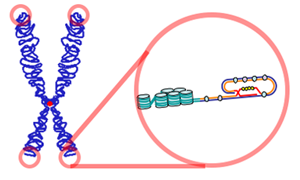The Hayflick Limit
January 20, 2014
In 1961 microbiologist Leonard Hayflick demonstrated that a population of human fetal cells in a cell culture will divide approximately 50 times before they stop. With each cell division in our body the ends of our chromosomes, the telomeres, get slightly shorter. This process continues until they shorten to a critical length, appropriately called the Hayflick limit. At this point the cells continue to live, but they stop replication. Because they can no longer replicate, damage accumulates and they simply become older.
It’s been suggested that tall people age faster, and therefor die younger, because they reach the Hayflick limit sooner. A larger body requires more cell doublings due to the ongoing regeneration of tissues over a lifetime. Ultimately this results in the exhaustion of the regeneration potential and the early onset of age-associated diseases, predominantly in large-bodied males. Contrary to normal human cells, cancer cells have the ability to override the telomeric counting mechanism, making themselves immortal, uncontrollable and equally, if not more, deadly than ageing itself. So it’s not just a matter of stopping the clock. One way or the other, abundant growth leads to a much shorter than possible lifespan. Considering the great cost of being tall, both for the individual body and the planet, perhaps it is time we rethink in what direction we want our bodies to evolve.